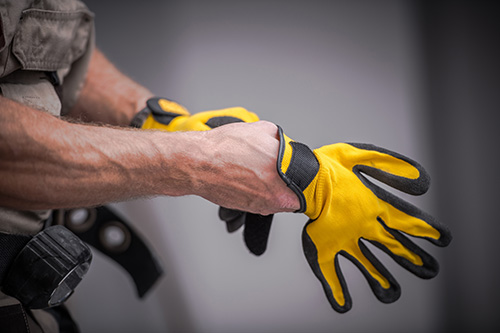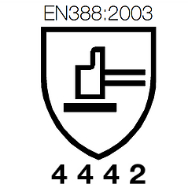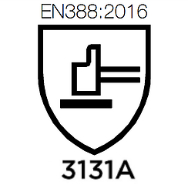EN 388:2016 Explained
We recently published a blog post about the changes to chemical resistance testing standards with the revision of EN 374:2003 to EN 374:2016. At the same time that these standards were changed, EN 388:2003 – the specific standards used to regulate the mechanical protection provided by safety gloves – was also updated. As with EN 374, the revised EN 388:2016 requires that gloves undergo more rigorous and more comprehensive testing to promote greater user safety. Here's a summary of the major changes to help you get to grips with the new standards:

Certification Under EN 388:2003
Under EN388:2003, gloves were rated for their resistance to abrasion, cut, tear and puncture. The level of resistance provided against each of these hazards was indexed below the EN:388 symbol. The resistance ratings were listed from left to right in the order of abrasion; cut; tear; and puncture, with resistance represented by a rating from 1 (minimal protection) to 5 (the highest rating awarded). This is what the old marking looks like:

A glove bearing this marking would have received resistance ratings of:
| Mechanical Hazard | Rating Received |
|---|---|
| Abrasion | Level 4 |
| Cut | Level 4 |
| Tear | Level 4 |
| Puncture | Level 2 |
What Has Changed in Under EN 388:2016?
There are three main differences to the new standard. These are abrasion resistance, cut resistance and impact resistance. We explore them fully below:
Abrasion Resistance
Abrasion testing is now carried out using different test paper. As a result, gloves may receive a different score under EN 388:2016 to the score originally awarded under EN 388:2003. So don't be alarmed if you're gloves have a different rating under the new standard to what they do in the old, this still means that your gloves offer abrasion resistance, however it may be a little lower depending on how they react to this new type of paper.
Cut Resistance Testing
The main change under EN 388:2016 is that the gloves will now be tested to a circular blade cut (ISO Cut Resitance) and a straight blade cut. In 2003, they where tested to a circular blade only. This means the following:
- An extra line in the EN 388 table will be allocated to a gloves straight blade cut results
- Sometimes a glove will receive a score for both circular blade cut and straight blade cut
- Other times a glove will receive a score for straight blade cut only
Below you can see how to recognise the two different results.
| Hazard | Level of Resistance |
|---|---|
| Abrasion Resistance | Level 1 |
| Cut Resistance (Circular Blade) | Level 1 |
| Tear Resistance | Level 1 |
| Puncture Resistance | Level 1 |
| ISO Cut Resistance (Straight Blade) | Level A |
Straight blade cut means that gloves will receive between a Level A and a Level F, with Level F being the highest that a glove can achieve. If a glove is not tested to a circular blade, the table will look like this.
| Hazard | Level of Resistance |
|---|---|
| Abrasion Resistance | Level 1 |
| Cut Resistance | N/A |
| Tear Resistance | Level 1 |
| Puncture Resistance | Level 1 |
| ISO Cut Resistance | Level A |
What Else Do I Need to Know About the Cut Resistance Change?
Circular blade testing is now carried out for more cycles than previously, which means that it is harder for gloves to achieve a higher level of cut resistance than before. This means that under the new standard, a gloves cut resistance may appear lower in 2016 than it did in 2003.
Secondly, because the straight blade cut test (ISO Cut Resistance) is carried out using a different type of blade, it means that there is little correlation between the straight cut resistance and the circular cut resistance. Generally speaking, gloves that achieve a Level C or above with the circular blade cut, will achieve a level 5 in the straight blade cut. This means that highest level of cut resistance under the new standard (Level C to Level F) is more comprehensive and accurate.
Impact Protection Testing
Where applicable, a rating for impact protection is now included under EN 388:2016. This means that if a glove claims impact resistant properties, it will be tested to ensure the validity of this claim. The impact protection score will only be included in the table if applicable, and if it is, it will be recognised by the letter P, and the table will look like this.
| Hazard | Level of Resistance |
|---|---|
| Abrasion Resistance | Level 1 |
| Cut Resistance | N/A |
| Tear Resistance | Level 1 |
| Puncture Resistance | Level 1 |
| ISO Cut Resistance | Level A |
| Impact Protection | P |
New Markings of EN 388:2016
The new order of performance rating (from left to right) is abrasion; circular blade cut; tear; puncture; and straight blade cut (EN ISO cut). The new rating received for cut resistance is classified using the letters A to F, with "F" being the highest level, and "A" being the lowest. If a glove provides protection against impact, this will be denoted with a sixth symbol – a "P" – underneath the EN 388:2016 marking. Here's an example of the EN 388:2016 marking:

This glove would be classified as:
| Mechanical Hazard | Rating Received |
|---|---|
| Abrasion | Level 3 |
| Cut | Level 1 |
| Tear | Level 3 |
| Puncture | Level 1 |
| EN ISO Cut | A |
Final Thoughts
While this all seems a bit confusing and overwhelming – particularly when you see a conformity statement with both the EN 388:2003 and EN 388:2016 markings – this breakdown has hopefully helped you to understand the new standards a bit better. If you have any questions, or anything to add, tell us in the comments below, or find us on Facebook and Twitter.


Please would you link me to a customer care representative to help me with some quotes?